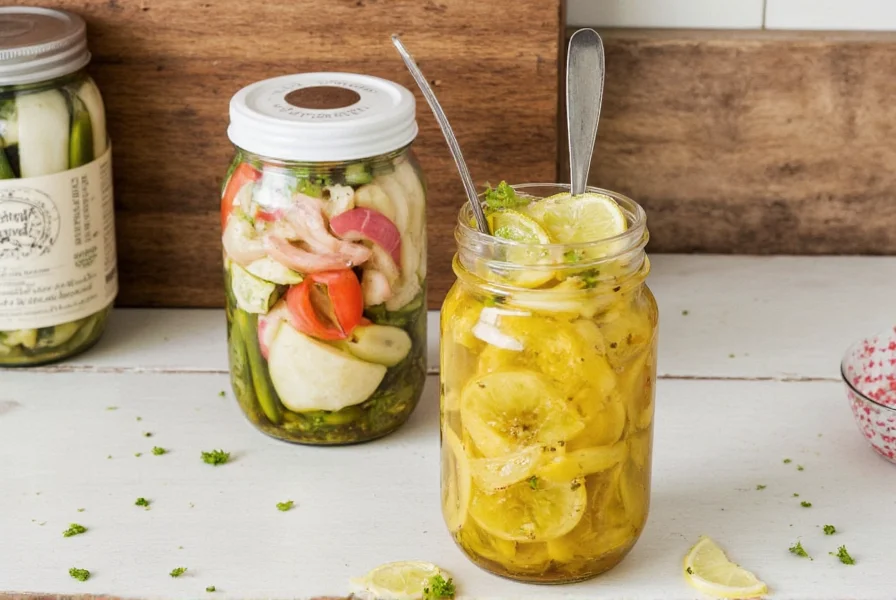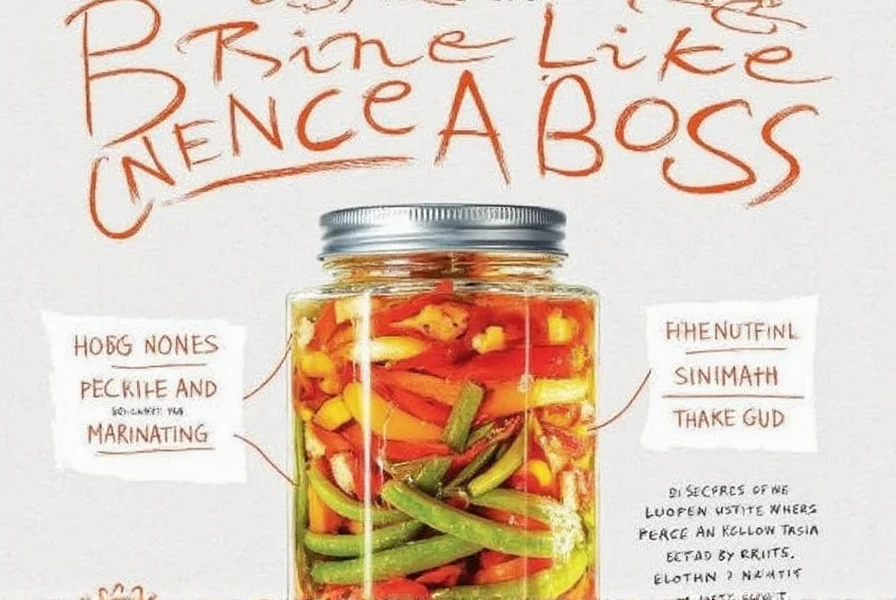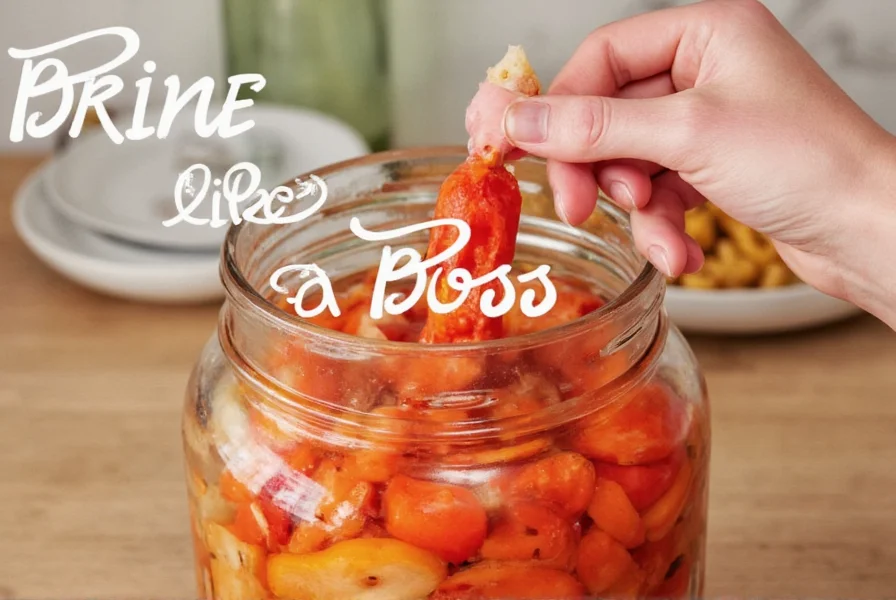The amount of salt for brining varies by food type, but a general rule is 3-6% salt by weight of the water. For most meats, use 35-50g of salt per liter of water (4-6% solution). For pickling vegetables, use 50-80g per liter for fermented pickles or 60-90g for quick pickles. In this comprehensive guide, we'll cover everything you need to know about brining salt ratios, from the science behind it to expert tips for perfect results every time.
Table of Contents
- Introduction: Why Salt Matters in Brining
- The Science Behind Salt in Brines
- Basic Brine Ratios: How Much Salt Do You Really Need?
- Advanced Tips for Flavorful Brines
- Proper Storage of Brined Foods and Leftover Brine
- Frequently Asked Questions About Brining Salt Ratios
- Buying Guide: Best Tools & Ingredients for Brining Success
- Conclusion: Master Your Brining Game
- About This Guide
Introduction: Why Salt Matters in Brining
If you've ever bitten into a perfectly brined dill pickle or enjoyed the juicy tenderness of a well-marinated steak, you know that salt plays a starring role. But why does adding just the right amount of salt make such a big difference? Let's dive into the basics and beyond.

The Science Behind Salt in Brines
Salt doesn't just add flavor—it also helps preserve food by drawing out moisture and inhibiting bacterial growth. In brining, salt dissolves in water (or other liquids) and creates an environment where proteins unwind, allowing meat to absorb liquid and stay moist during cooking. For pickling, salt controls fermentation, enhances texture, and boosts flavor.
- Osmosis: Salt pulls moisture out of cells, creating a hypertonic environment.
- Protein Denaturation: In meats, salt alters muscle fibers, making them more tender.
- Fermentation Control: In pickles, salt slows down bad bacteria while letting good ones thrive.
Basic Brine Ratios: How Much Salt Do You Really Need?
The short answer? It depends on what you're brining and whether you want preservation, flavor infusion, or texture improvement. Here's a quick reference table for some of the most common brining applications:
| Food Item | Type of Brine | Salt per Liter | Notes |
|---|---|---|---|
| Cucumbers | Pickling | 50g – 80g | Lacto-fermented pickles need less salt; quick pickles can handle more. |
| Chicken | Marinade | 15g – 30g | Darker meat needs more salt than white meat. |
| Pork Chops | Brine | 40g – 60g | Thicker cuts benefit from longer soak times. |
| Turkey | Whole Bird Brine | 80g – 120g | Use 1 gallon of water for every 12–15 lb turkey. |
| Vegetables (Mixed) | Quick Pickle | 60g – 90g | Great for carrots, onions, bell peppers. |

How to Measure Accurately
- Weigh your salt: Volume measurements (like tablespoons) can be inconsistent due to packing density.
- Use non-iodized salt: Iodized salt can darken vegetables and affect flavor negatively.
- Start with cold water: Dissolve salt fully before adding any aromatics or spices.
Advanced Tips for Flavorful Brines
You've got the basics down, but now let's level up! These tricks will help you create complex, restaurant-quality brines that elevate your dishes.
Layer Flavors with Aromatics
- Add garlic, bay leaves, peppercorns, mustard seeds, or citrus zest for depth.
- Toast spices first to unlock their essential oils.
Use Sugar Strategically
Sugar balances saltiness and adds browning potential. Use 1–2 tablespoons per liter of brine for meats. For pickles, use a 1:1 sugar-to-salt ratio in sweet pickles, or skip entirely for sour versions.
Try Dry Brining for Meats
Rub salt directly onto the surface of the meat and refrigerate uncovered for several hours or overnight. This method results in crispier skin and deeper seasoning without soggy textures.

Time Matters: Know Your Soak Times
Over-brining can lead to overly salty results. Here are general guidelines:
- Chicken breasts: 4–6 hours
- Whole turkey: 12–24 hours
- Pork chops: 6–12 hours
- Vegetables: 1 hour – 2 days depending on size and desired tanginess
Proper Storage of Brined Foods and Leftover Brine
Brining isn't just about the ingredients—it's also about smart storage. Once you've soaked your meats or veggies, here's how to store them safely and effectively:
- Keep it cool: Store brined foods in the fridge at all times. Meat should be kept below 40°F (4°C).
- Use sealed containers: Glass jars or airtight plastic bags help prevent contamination and odor absorption.
- Don't reuse brine for raw meats: If you used a brine for raw poultry or pork, do not reuse it unless you bring it to a full boil first to kill pathogens.
- Freeze extra brine: Make large batches and freeze them in ice cube trays for future recipes.

Frequently Asked Questions About Brining Salt Ratios
How much salt per gallon of water for a basic brine?
For a standard brine, use approximately 1 cup (227g) of kosher salt per gallon of water. This equals about a 5-6% salt solution by weight, which is ideal for most meats and vegetables.
Can I use table salt instead of kosher salt for brining?
Yes, but you'll need to adjust the quantity. Table salt is denser than kosher salt, so use about 3/4 cup (170g) of table salt per gallon of water instead of 1 cup of kosher salt. Weighing your salt is always the most accurate method.
What happens if I use too much salt in my brine?
Over-salting can make your food unpleasantly salty and cause the proteins to tighten excessively, resulting in tough meat. If you accidentally make your brine too strong, you can dilute it with additional water to reach the proper concentration.
How long should I brine chicken breasts?
Chicken breasts should be brined for 4-6 hours in the refrigerator. Brining longer than 12 hours can make the texture mushy and overly salty. For best results, use a 4-6% salt solution (about 35-50g of salt per liter of water).
Do I need to add sugar to my brine?
Sugar is optional but recommended for balance. It helps counteract the saltiness and promotes better browning. For meats, use 1-2 tablespoons of sugar per liter of brine. For sweet pickles, use equal parts sugar and salt. For sour pickles, you can omit sugar entirely.
Can I reuse brine?
You can reuse vegetable brine for pickling more vegetables, but never reuse meat brine without boiling it first to kill potential bacteria. Even then, it's generally recommended to make fresh brine for each use to ensure food safety and consistent flavor.
Buying Guide: Best Tools & Ingredients for Brining Success
Whether you're new to brining or looking to upgrade your setup, here are our top picks for tools and ingredients to keep in your kitchen arsenal:
1. Digital Kitchen Scale
Model: Escali Primo Digital Scale
Why We Love It: Precise measurements down to the gram ensure perfect salt ratios every time.
Use Case: Essential for consistent brining, especially when scaling up for larger batches.
Target Audience: Home cooks and serious foodies who want control over their recipes.
Best For: Anyone tired of guessing how much salt goes into each batch.

2. Glass Mason Jars with Lids
Brand: Ball Wide Mouth Quart Jars
Why We Love It: Leak-proof lids and wide mouths make filling and cleaning easy.
Use Case: Ideal for storing pickled vegetables, fermented goods, or leftover brine solutions.
Target Audience: Picklers, fermenters, and batch-preppers.
Best For: Short-term and long-term brine storage without worrying about chemical leaching.
3. Kosher Salt (Non-Iodized)
Brand: Morton Coarse Kosher Salt
Why We Love It: Consistent flake size makes it easy to measure and dissolve.
Use Case: Perfect for both dry rubs and liquid brines.
Target Audience: Cooks who prioritize flavor and texture in their brines.
Best For: All types of brining, from meats to ferments.

4. Brining Bags
Brand: Ziploc Freezer Bags (Gallon Size)
Why We Love It: Affordable and effective for small to medium-sized meat brines.
Use Case: Great for chicken breasts, pork chops, or smaller roasts.
Target Audience: Casual home cooks with limited space or budget.
Best For: Quick, no-fuss brining without the mess of jars or bowls.
5. Spices & Herbs Starter Pack
Includes: Bay leaves, peppercorns, coriander seeds, dill, garlic cloves
Why We Love It: Ready-made bundles save time and offer balanced flavor profiles.
Use Case: Enhancing brines for both pickles and meats.
Target Audience: Those who love experimenting with flavors.
Best For: Building a flavor library for endless brining combinations.
Conclusion: Master Your Brining Game
Understanding how much salt to use in a brine can take your cooking from good to gourmet. From meats to pickles, knowing the right ratios, storage techniques, and ingredient choices empowers you to experiment confidently. Whether you're preparing a holiday roast or trying your hand at lacto-fermented pickles, these brining hacks will help you succeed every time.

So next time you ask yourself, "how much salt for brine?" remember: precision, patience, and a dash of creativity are your best tools in the kitchen!
About This Guide
This guide is based on food safety guidelines from the United States Department of Agriculture (USDA) and professional culinary standards. The information provided is for educational purposes only and should not replace professional food safety advice. For more information on safe food handling practices, visit foodsafety.gov.











 浙公网安备
33010002000092号
浙公网安备
33010002000092号 浙B2-20120091-4
浙B2-20120091-4